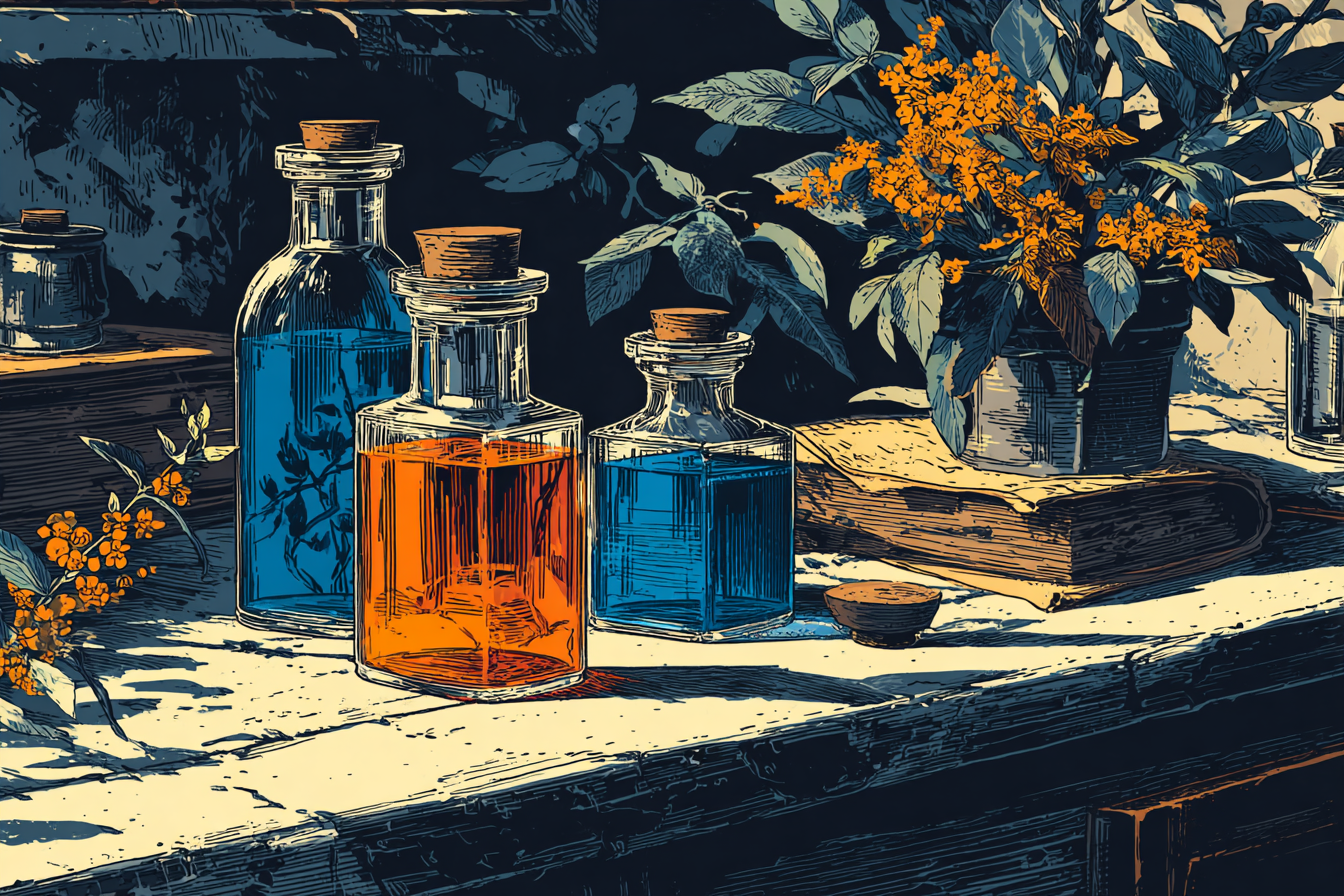The fascinating world of essential oils: a guide for beginners

In old apothecaries, glass vials held more than scent—they held ritual, memory, and mood. Essential oils still carry that spell today. This guide shows you how to start your own tiny “laboratory” at home: what essential oils are, how to use them safely, and a few simple formulas to begin.
What essential oils are (and aren’t)
Essential oils are highly concentrated aromatic extracts from plants—flowers, leaves, bark, peels, resins. They’re not perfume in the modern sense and not the same as “fragrance oils.” A few drops go a long way because they’re packed with volatile compounds that evaporate into the air and reach your nose quickly.
How they’re made
- Steam distillation: the classic method for woods, herbs, and flowers.
- Cold pressing: mainly for citrus peels (orange, lemon, bergamot).
- CO₂ extraction: a cleaner, low-heat method that can capture delicate notes.
- Absolutes: solvent-extracted aromatics (e.g., jasmine absolute). Wonderful for perfumery, but technically not essential oils.
Safety first: the quick-start rules
Treat essential oils like alchemical reagents: potent, beautiful, and deserving respect.
- Dilute for skin use.
- Face: ~1% (about 6 drops total per 30 mL / 1 oz carrier).
- Body: ~2% (about 12 drops per 30 mL / 1 oz).
- Short, localized use: up to ~3% if your skin tolerates it.Always patch test new blends.
- Phototoxic citrus caution.Some cold-pressed citrus oils (especially bergamot, some lemon/lime) can increase sun sensitivity. Avoid sun on freshly treated skin and skip oxidized/old citrus oils on the skin entirely. Sweet orange is generally gentler, but freshness still matters.
- Diffusion basics.Diffuse intermittently (30–60 minutes on, then a break) and keep rooms ventilated. Less is more.
- Baths need a dispersant.Never drop oils straight into bathwater. Pre-mix with a solubilizer (e.g., polysorbate 20 or a dedicated bath dispersant) so the oil actually disperses.
- Children, pregnancy, and health conditions.Be cautious. Avoid strong menthol/cineole oils (peppermint, some eucalyptus) around infants and young children. During pregnancy or if you have a medical condition, keep dilutions low and seek personalised advice.
- Pets.Cats, birds, and some dogs can be sensitive. Use in pet-free, well-ventilated spaces and stop immediately if an animal shows distress.
- No ingestion for beginners.Food-grade use requires precise knowledge, equipment, and tiny amounts. For home aromatherapy, stick to inhalation and properly diluted topical blends.
- Storage = longevity.Keep oils in dark glass, tightly capped, away from heat and light. Citrus oxidizes faster—buy small bottles and replace when the scent turns.
Choosing quality
Look for:
- Botanical (Latin) name on the label (e.g., Lavandula angustifolia).
- Plant part (leaf, peel, resin), country of origin, and extraction method.
- Chemotype where relevant (e.g., rosemary ct. 1,8-cineole vs ct. verbenone).
- Batch transparency (suppliers who share analysis or at least robust sourcing notes). Avoid vague “fragrance oils” if your goal is aromatherapy.
Your first shelf of bottles (a sensible starter set)
Start small: three to six versatile oils. Always check the Latin names.
- Lavender (Lavandula angustifolia) – soft, floral-herbal; a classic for evening wind-down and skin-friendly blends.
- Sweet Orange (Citrus sinensis) – bright, cheerful; excellent in diffuser blends.
- Tea Tree (Melaleuca alternifolia) – crisp, green; keep well diluted for targeted skin applications.
- Frankincense (Boswellia carterii/sacra) – resinous, meditative; pairs beautifully with citrus or lavender.
- Peppermint (Mentha × piperita) – cool and clarifying; avoid around infants/young children and keep away from the face.If you have kids, swap peppermint for spearmint (Mentha spicata) at gentler dilutions.
Carriers & tools to have
- Jojoba, fractionated coconut, or sweet almond oil (for dilutions).
- 10–30 mL amber bottles with droppers or pumps, roll-on bottles (10 mL) for pulse-point blends.
- A small bottle of solubilizer for baths and room mists.
- Labels (date every blend).
Beginner recipes (simple, safe, and effective)
All blends below are designed for healthy adults. Adjust down for sensitive skin and avoid before sun if using phototoxic citrus.
1) Evening Wind-Down (Diffuser)
- 3 drops lavender
- 2 drops sweet orange Diffuse for 30–45 minutes in a ventilated room.
2) Clarity at the Desk (Diffuser)
- 2 drops frankincense
- 2 drops sweet orange
- 1 drop peppermint (omit if sensitive or if children are present)
3) 2% Everyday Body Oil (30 mL / 1 oz)
- 30 mL jojoba (or other carrier)
- 8 drops lavender
- 4 drops sweet orange
Label, shake gently, and store cool and dark.
4) Pulse-Point Roll-On (1%, 10 mL)
- 10 mL jojoba
- 3 drops frankincense
- 2 drops lavender
Apply to wrists/neck as a light aromatic cue.
5) Proper Bath Ritual (dispersed)
- 3–5 drops total essential oil (e.g., 3 lavender + 2 frankincense)
- Mix with an equal amount of solubilizer, then stir into a full tub after you’re seated. Avoid “hot” oils. Do not add oils neat to water.
6) Linen & Room Mist (shake before each use)
- 50 mL distilled water
- 50 mL alcohol (vodka or perfumer’s alcohol) or add a solubilizer as directed
- Up to 40 drops total essential oil (start lower; test on fabrics)
Good combos: orange + frankincense; lavender solo; lavender + spearmint (very light).
Common pitfalls (learn these now, skip the regrets)
- Using oils neat on skin as a habit.
- Adding drops directly to bathwater.
- All-day, heavy diffusion.
- Strong oils around infants/young children.
- Keeping bottles open or in bright, warm places.
- Assuming “natural = harmless.” Sensitization happens—respect your skin’s limits.
Quick FAQ
Do essential oils expire?
They oxidize over time. Citrus and pine-like oils fade fastest; resins and woods often last longer. If the scent is sharp, varnish-like, or just “off,” retire it.
Are absolutes essential oils?
No. They’re solvent-extracted aromatics used mainly in perfumery. Gorgeous, but a different category.
What’s the difference between essential oils and “fragrance oils”?
Fragrance oils are usually aromatic compounds blended for scent, not whole-plant extracts. If you want traditional aromatherapy, choose essential oils.
Can I use oils in pregnancy or with health conditions?
Keep dilutions very low, avoid certain oils, and consult a qualified practitioner. When in doubt, pause.
The Crazy Alchemist way
Think of essential oils as tools for small, daily rituals—tiny spells for mood, focus, or rest. Build slowly. Label everything. Record what works. And above all, keep curiosity and respect in equal measure.





